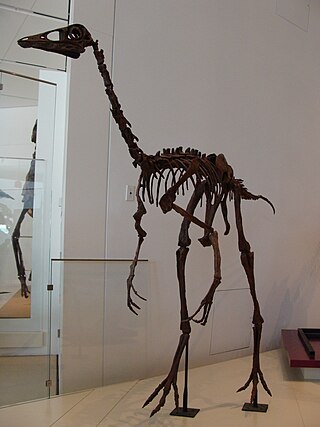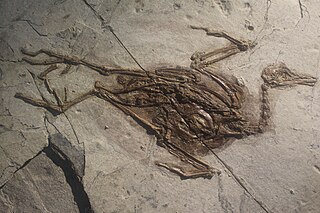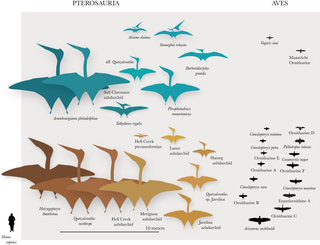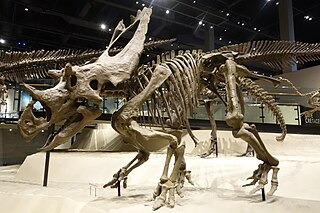
Pteranodon is a genus of pterosaur that included some of the largest known flying reptiles, with P. longiceps having a wingspan of over 6 m (20 ft). They lived during the late Cretaceous geological period of North America in present-day Kansas, Nebraska, Wyoming, South Dakota and Alabama. More fossil specimens of Pteranodon have been found than any other pterosaur, with about 1,200 specimens known to science, many of them well preserved with nearly complete skulls and articulated skeletons. It was an important part of the animal community in the Western Interior Seaway.

The Western Interior Seaway was a large inland sea that split the continent of North America into two landmasses for 34 million years. The ancient sea, which existed from the early Late Cretaceous to the earliest Paleocene, connected the Gulf of Mexico to the Arctic Ocean. The two land masses it created were Laramidia to the west and Appalachia to the east. At its largest extent, it was 2,500 feet (760 m) deep, 600 miles (970 km) wide and over 2,000 miles (3,200 km) long.

Ichthyornis is an extinct genus of toothy seabird-like ornithuran from the late Cretaceous period of North America. Its fossil remains are known from the chalks of Alberta, Alabama, Kansas, New Mexico, Saskatchewan, and Texas, in strata that were laid down in the Western Interior Seaway during the Turonian through Campanian ages, about 95–83.5 million years ago. Ichthyornis is a common component of the Niobrara Formation fauna, and numerous specimens have been found.

Hesperornis is a genus of cormorant-like Ornithuran that spanned throughout the Campanian age, and possibly even up to the early Maastrichtian age, of the Late Cretaceous period. One of the lesser-known discoveries of the paleontologist O. C. Marsh in the late 19th century Bone Wars, it was an early find in the history of avian paleontology. Locations for Hesperornis fossils include the Late Cretaceous marine limestones from Kansas and the marine shales from Canada. Nine species are recognised, eight of which have been recovered from rocks in North America and one from Russia.

Ornithomimus is a genus of ornithomimid theropod dinosaurs from the Campanian and Maastrichtian ages of Late Cretaceous Western North America. Ornithomimus was a swift, bipedal dinosaur which fossil evidence indicates was covered in feathers and equipped with a small toothless beak that may indicate an omnivorous diet. It is usually classified into two species: the type species, Ornithomimus velox, and a referred species, Ornithomimus edmontonicus. O. velox was named in 1890 by Othniel Charles Marsh on the basis of a foot and partial hand from the Denver Formation of Colorado. Another seventeen species have been named since then, though almost all of them have been subsequently assigned to new genera or shown to be not directly related to Ornithomimus velox. The best material of species still considered part of the genus has been found in Alberta, representing the species O. edmontonicus, known from several skeletons from the Horseshoe Canyon Formation. Additional species and specimens from other formations are sometimes classified as Ornithomimus, such as Ornithomimus samueli from the earlier Dinosaur Park Formation.

Gryposaurus was a genus of duckbilled dinosaur that lived about 80 to 75 million years ago, in the Late Cretaceous of North America. Named species of Gryposaurus are known from the Dinosaur Park Formation in Alberta, Canada, and two formations in the United States: the Lower Two Medicine Formation in Montana and the Kaiparowits Formation of Utah. A possible additional species from the Javelina Formation in Texas may extend the temporal range of the genus to 66 million years ago.

Parksosaurus is a genus of neornithischian dinosaur from the early Maastrichtian-age Upper Cretaceous Horseshoe Canyon Formation of Alberta, Canada. It is based on most of a partially articulated skeleton and partial skull, showing it to have been a small, bipedal, herbivorous dinosaur. It is one of the few described non-hadrosaurid ornithopods from the end of the Cretaceous in North America, existing around 70 million years ago.

Hagryphus is a monospecific genus of caenagnathid dinosaur from southern Utah that lived during the Late Cretaceous in what is now the Kaiparowits Formation of the Grand Staircase–Escalante National Monument. The type and only species, Hagryphus giganteus, is known only from an incomplete but articulated left manus and the distal portion of the left radius. It was named in 2005 by Lindsay E. Zanno and Scott D. Sampson. Hagryphus has an estimated length of 2.4–3 metres and weight of 50 kilograms.

Gansus is a genus of aquatic birds that lived during the Aptian age of the Early Cretaceous (Aptian-Albian) period in what are now Gansu and Liaoning provinces, western China. The rock layers from which their fossils have been recovered are dated to 120 million years ago. It was first described in 1984 on the basis of an isolated left leg. It is the oldest-known member of the Ornithurae, the group which includes modern birds (Neornithes) and extinct related groups, such as Ichthyornis and Hesperornithes.

Ichthyornithes is an extinct group of toothed avialan dinosaurs very closely related to the common ancestor of all modern birds. They are known from fossil remains found throughout the late Cretaceous period of North America, though only two genera, Ichthyornis and Janavis, are represented by complete enough fossils to have been named. Ichthyornitheans became extinct at the Cretaceous–Paleogene boundary, along with enantiornitheans, all other non-avian dinosaurs, and many other animal and plant groups.

Protostega is an extinct genus of sea turtle containing a single species, Protostega gigas. Its fossil remains have been found in the Smoky Hill Chalk formation of western Kansas, time-equivalent beds of the Mooreville Chalk Formation of Alabama and Campanian beds of the Rybushka Formation. Fossil specimens of this species were first collected in 1871, and named by Edward Drinker Cope in 1872. With a total length of 3.9 metres (13 ft), it is the second-largest sea turtle that ever lived, second only to the giant Archelon, and one of the three largest turtle of all time along Archelon and Gigantatypus.

The Bearpaw Formation, also called the Bearpaw Shale, is a geologic formation of Late Cretaceous (Campanian) age. It outcrops in the U.S. state of Montana, as well as the Canadian provinces of Alberta and Saskatchewan, and was named for the Bear Paw Mountains in Montana. It includes a wide range of marine fossils, as well as the remains of a few dinosaurs. It is known for its fossil ammonites, some of which are mined in Alberta to produce the organic gemstone ammolite.
Piksi is a potential pterosaur genus containing the single species Piksi barbarulna. It lived roughly 75 million years ago in what is now Montana, United States. Known from parts of a right wing – the humerus, ulna and radius bones – the only specimens found so far are housed in the Museum of the Rockies. The genus Piksi is monotypic at present.
Halimornis was an enantiornithean bird. It lived during the Late Cretaceous about 80 mya and is known from fossils found in the Mooreville Chalk Formation in Greene County, Alabama. It is known from a single fossil individual, including preserved vertebrae, leg bones and part of the humerus.

Palintropus is a prehistoric bird genus from the Late Cretaceous. A single species has been named based on a proximal coracoid from the Lance Formation of Wyoming, dated to the latest Maastrichtian, 66 million years ago. Coracoids and a proximal scapula of two unnamed species from the upper Campanian Dinosaur Park Formation of Alberta, dating to between 76.5 and 75 million years ago, are also known.
Limenavis is a genus of ornithuran dinosaurs from the Late Cretaceous. It lived about 70 million years ago, around the Campanian-Maastrichtian boundary. Known from several broken bones, the remains of the only known species Limenavis patagonica were found in rocks of the "lower member" of the Allen Formation at Salitral Moreno, 20 km south of General Roca, Río Negro (Argentina). It is one of the closest relatives, in the fossil record, of the modern birds.
Palaeotringa is a prehistoric bird genus that was discovered by O. C. Marsh during the late 19th century American bone wars. Its remains were found in the controversial Hornerstown Formation of New Jersey which straddles the Cretaceous-Paleocene boundary some 66 million years ago. Though it cannot be said if these birds lived before or after the Cretaceous–Paleogene extinction event, they were in all likelihood wading birds that inhabited the coasts of the northwestern Atlantic.

During the time of the deposition of the Niobrara Chalk, much life inhabited the seas of the Western Interior Seaway. By this time in the Late Cretaceous many new lifeforms appeared such as mosasaurs, which were to be some of the last of the aquatic lifeforms to evolve before the end of the Mesozoic. Life of the Niobrara Chalk is comparable to that of the Dakota Formation, although the Dakota Formation, which was deposited during the Cenomanian, predates the chalk by about 10 million years.

Utahceratops is an extinct genus of ceratopsian dinosaur that lived approximately 76.4~75.5 million years ago during the Late Cretaceous period in what is now Utah. Utahceratops was a large-sized, robustly-built, ground-dwelling, quadrupedal herbivore, that could grow up to an estimated 4.5–5 m (15–16 ft) long.
Talos is an extinct genus of carnivorous bird-like theropod dinosaur, an advanced troodontid which lived during the late Cretaceous period in the geographic area that is now Utah, United States.
















